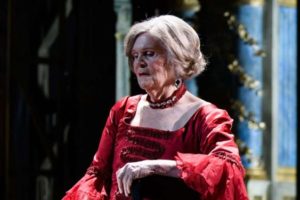
When sending out CDs to for me to review, our doyenne could not know that I have a fetish for 1950s vintage import LP jackets. I remember combing through the LP bins gazing admiringly at the import disks of a generation of middle-European singers who I was too young to have heard in person, who had no or negligible American careers anyhow, and yet whose names were legendary to me. The black and white portraits stared out at me in a way that was enticing yet forbidding.
The CD that greeted me this afternoon, Rita Streich Waltzes & Arias (Newton Classics 8802069), featured a charming portrait (with the obligatory string of pearls) of the delightful coloratura Rita Streich. Along with Erika Köth, Wilma Lipp, Emmy Loose and Lisa Otto she was one of a generation of light sopranos whose careers flourished in Germany and Austria in the 1950s and whose agreeable timbres were featured on Decca, EMI, and Deutsche Grammophon recordings from that decade.
Streich was a protégée of Erna Berger and sang many of her mentor’s roles. Her stage career was centered in Berlin and Vienna, with guest outings to Bayreuth for the Woodbird (in Krauss’ 1953 Ring). Her repertoire was as wide as that voice type would support and included Mozart, Strauss, and even some Puccini (websites and record notes like to point that it is her recording of “O mio babbino caro” that Rowan Atkinson lip-synchs to in Mr. Bean’s Holiday.)
But I’ll always think of her as the most perfect Zerbinetta (for Karajan with Schwarzkopf), a light but still effective Queen of the Night (Fricsay), a charming Sophie (Böhm), and above all a delectable Adele (Karajan). She was also known for Susanna, Blondchen, and Annchen, all staples of the lyric coloratura rep. She was a Lieder singer of great accomplishment and excelled at the bon-bons , which make up the bulk of the disk under consideration.
Waltzes & Arias is an eclectic mix of lighter songs and arias that allows the singer’s innate charm and expert vocalism to shine through.
Waltzes and Arias is heavy on the former and gets off to a great start with Johann Strauss’ “Frühlingstimmen.” With a somewhat breathless charm, a shimmering vibrato, and a timbre while thin, contains more shades of light and dark than some of her rivals, she captures the lilt and joy of this classic. I particularly enjoy that throughout her range (including the uppermost notes) she retains the integrity of her vocal quality.
On the whole it is while she is singing in her native tongues that she shines brightest on this varied program. I find her happiest in pieces like “Dorfschwalben in Osterwald”, and “Draussen in Sievering.” In Alyabyev’s The Nightingale (sung in Russian; she was born in Russia to Russian and German parents and thus bilingual) she is both introspective in its opening and fluent in its vocalization.
I loved Le Rossignol et la Rose (Saint-Saëns) where her timbre beautifully contrasts the harp accompaniment. The “Berceuse” from Godard’s Jocelyn is perhaps a little less successful (well sung but the text could use more specificity) but she brilliantly captures the mood of Delibes’ “Les Filles de Cadix.”
Am I being churlish for wanting something a little more in the Italian songs? Verdi’s La spazzocamino is beautifully vocalized but I felt the need for more idiomatic articulation of the text. Meyerbeer’s “Ombra leggiera” (sung in Italian not in German as indicated in the liner notes) seems superficial and lacking in both ombra and leggiera. Il Bacio seems to me to require more joie de vivre. And I hope she would have pardoned that my smile turned to a laugh when halfway through The Last Rose of Summer I discovered that it was being sung in English.
The surprise on this album for me was the “Song to the Moon”. With a slim vocal weight that I never thought would be able to sustain this aria, Streich magically conveys its mystery and light. The high phrases float as expected, but in the lower and middle range her voice takes on a smoky quality that communicates the rapture of this doomed water nymph. Just gorgeous!
So minor quibbles aside, I enjoyed this remembrance of a singer in pearls whose charm always has brought a smile to my face. I’ll listen to this again and again (perhaps occasionally skipping over the Italian songs) and think of those LP jackets.

























Comments